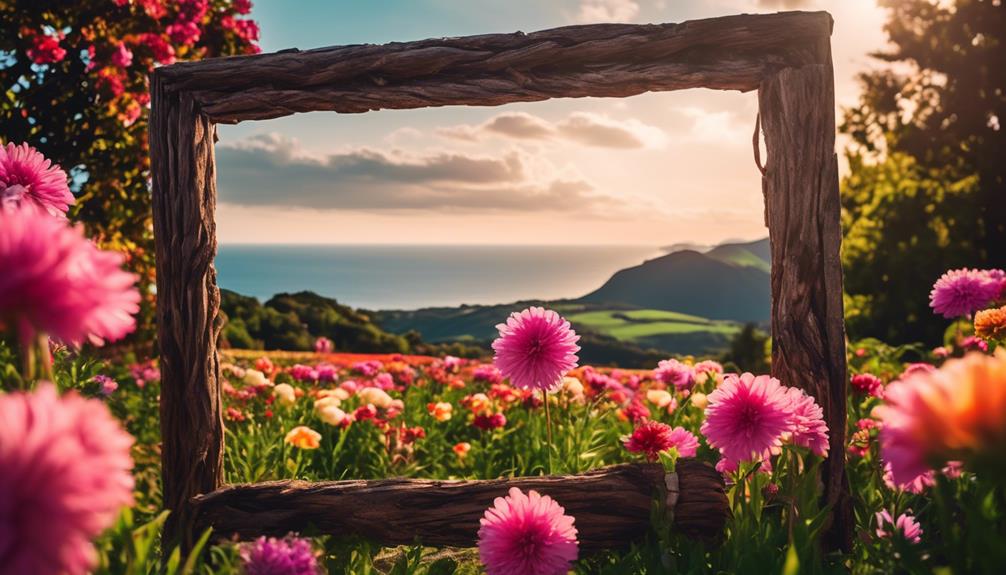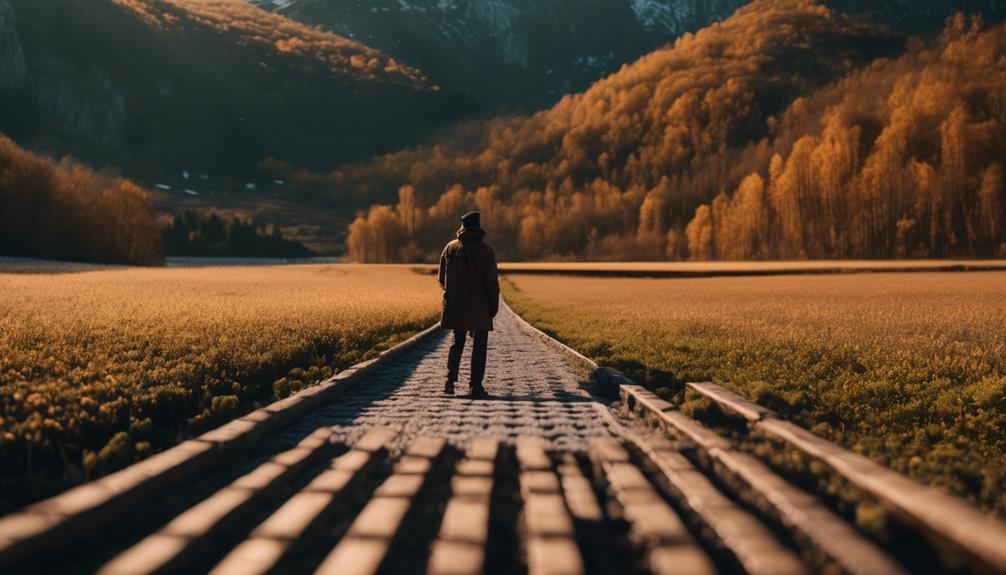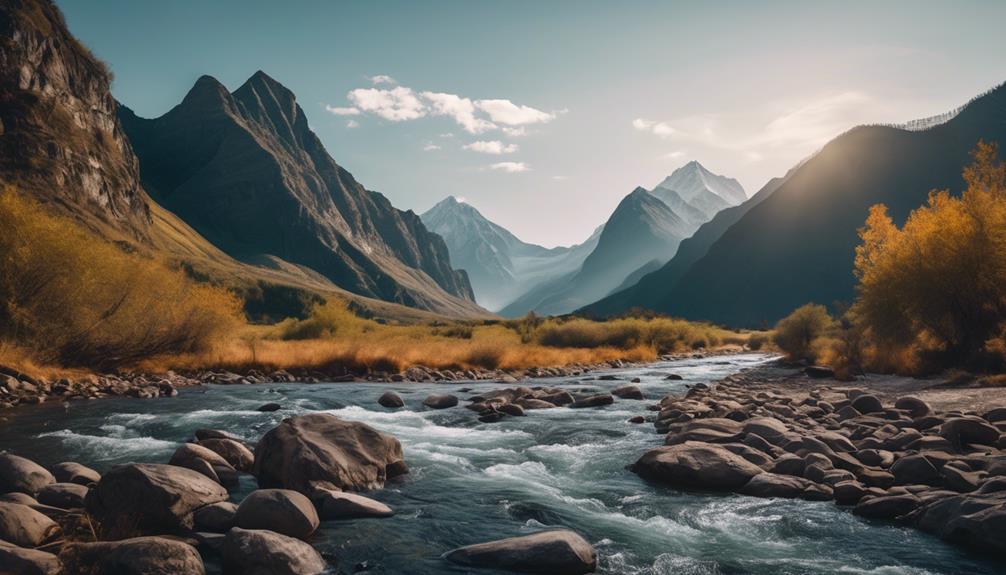Please note this post may contain affiliate links picked by me (Jay) that I have deemed may be of interest or relevant to you the reader of this.
These links do not affect the cost of the thing if you decide to purchase but i may get a little money if you choose to purchase.
For more information on my affiliate link policy click here.
As I stood on the edge of the cliff, capturing the breathtaking sunset with my camera, I couldn't help but think about how I could enhance the composition of my photos. That's when I discovered the power of the Rule of Thirds.
This simple yet effective technique has the potential to transform your ordinary snapshots into stunning works of art. With six practical tips to master the Rule of Thirds, you'll be able to create visually captivating images that draw viewers in and leave them wanting more.
So, if you're ready to take your photography skills to the next level, let's dive into the world of the Rule of Thirds and unlock the potential of your photos.
Key Takeaways
- The Rule of Thirds is a fundamental concept in photography that enhances composition.
- Placing main elements along the grid lines or their intersections creates visually appealing images.
- Balancing elements and utilizing negative space enhances composition and draws attention to the main subject.
- Incorporating leading lines within the frame guides the viewer's eye towards the main subject and adds depth to the image.
Understanding the Rule of Thirds
Understanding the Rule of Thirds is a fundamental concept that can greatly enhance your photography skills and take your images to the next level. Whether you're capturing breathtaking landscapes or stunning portraits, the rule of thirds is a technique that can add balance, harmony, and visual interest to your photos.
In landscape photography, the rule of thirds involves dividing your frame into nine equal parts by overlaying two horizontal and two vertical lines. The main elements of your composition, such as the horizon or the focal point, should then be placed along these lines or at their intersections. By doing so, you create a visually appealing image that draws the viewer's attention to the most important elements of the scene.
For example, if you're capturing a sunset, you might position the horizon along the lower horizontal line to showcase the colorful sky while leaving the upper two-thirds of the frame for the stunning landscape below.
In portrait photography, the rule of thirds is equally powerful. Instead of placing your subject in the center of the frame, try positioning them off-center along one of the vertical lines. This technique can create a more dynamic composition and add depth to your photos. Additionally, aligning the subject's eyes with one of the horizontal lines can help establish a connection with the viewer and make the portrait more engaging.
Applying the Rule of Thirds Grid
To effectively apply the Rule of Thirds grid, you'll need to understand how to strategically position your main elements along the intersecting lines and create a visually captivating composition. By following this simple yet powerful rule, you can take your photos to the next level and create stunning images that grab the viewer's attention.
Here are three ways to apply the Rule of Thirds grid in your photography:
- Rule of Thirds Examples:
- Imagine a landscape photo with a breathtaking sunset. Instead of placing the horizon right in the middle of the frame, position it along the lower horizontal line. This will emphasize the beautiful colors of the sky while creating balance in the composition.
- In a portrait, place the subject's eyes along one of the vertical lines. This draws the viewer's gaze directly to the most important part of the photo, creating a more engaging and impactful image.
- When photographing a group of people, position the main subjects along the intersecting lines. This not only creates a sense of balance but also allows each person to have their own space within the frame.
- Rule of Thirds in Landscape Photography:
- When capturing a sweeping landscape, place the main subject, such as a mountain or a tree, along one of the vertical lines. This helps to create a sense of depth and adds interest to the composition.
- If there's a prominent foreground element, like a rock or a flower, position it along one of the bottom intersections. This adds depth and leads the viewer's eye into the photo.
- When photographing a sunset or sunrise, position the sun along one of the vertical lines. This not only creates a sense of balance but also adds drama and impact to the image.
Balancing Elements in Your Composition
Now that we've explored how to strategically position your main elements using the Rule of Thirds grid, let's delve into the art of balancing elements in your composition to create visually compelling photos.
Balancing elements is crucial in photography as it helps create harmony and visual interest in your images.
One important aspect of balancing elements is the effective use of negative space. Negative space refers to the empty or unoccupied areas in your composition. It provides breathing room for your main subject and helps draw attention to it. By carefully considering the placement and size of negative space, you can create a sense of balance and enhance the overall composition of your photo.
Another powerful technique to achieve balance is by using color contrast. Colors can evoke emotions and draw the viewer's attention. By incorporating contrasting colors, you can create a dynamic and visually appealing composition. For example, placing a brightly colored subject against a neutral or muted background can make it stand out and create a sense of balance in the image.
Framing Your Subject Using the Rule of Thirds
When framing your subject using the Rule of Thirds, you can create a visually striking composition by strategically positioning your main elements within the grid. This technique opens up a world of possibilities for exploring alternative framing techniques and unleashing your creativity.
Here are three ways you can use the Rule of Thirds to frame your subject and take your photos to the next level:
- Placing your subject off-center: Instead of placing your subject right in the center of the frame, try positioning it along one of the imaginary lines or at one of the intersection points on the grid. This creates a dynamic composition that draws the viewer's eye and adds interest to your photo.
- Utilizing negative space: Negative space refers to the empty areas in your photo. By intentionally leaving some space around your subject, you can create a sense of balance and emphasize your main element. This technique adds a minimalist and modern touch to your composition.
- Incorporating leading lines: Leading lines are elements in your photo that guide the viewer's eye towards your subject. By aligning these lines along the grid lines, you can create a powerful visual effect that enhances the overall composition. Whether it's a road, a fence, or a row of trees, leading lines provide a sense of depth and draw attention to your subject.
Leading Lines and the Rule of Thirds
Leading lines are a powerful compositional tool that can create captivating and visually stunning photographs when combined with the Rule of Thirds. Using leading lines to create dynamic compositions and incorporating the rule of thirds in landscape photography can truly elevate your images to the next level.
So, what exactly are leading lines? They're elements within a photograph that guide the viewer's eye towards the main subject or focal point. These lines can be found in various forms, such as roads, fences, rivers, or even the branches of a tree. By strategically positioning these lines within the frame, you can create a sense of depth and draw attention to the subject.
When incorporating the rule of thirds with leading lines, you can create a visually balanced and harmonious composition. Imagine dividing your frame into a 3×3 grid, with two horizontal and two vertical lines. By placing the leading lines along these lines or intersections, you can create a sense of balance and harmony, as well as guide the viewer's eye through the image.
In landscape photography, leading lines can be particularly effective in drawing the viewer's attention into the scene. For example, a winding path leading towards a majestic mountain or a river snaking through a lush valley can create a sense of depth and invite the viewer to explore the image further. By aligning these leading lines with the rule of thirds, you can create a more dynamic and visually pleasing composition.
Incorporating leading lines and the rule of thirds in your photography not only adds visual interest but also helps to create a more engaging and captivating image. So, next time you're out shooting, keep an eye out for those leading lines and experiment with different compositions. You might just be amazed at the results you can achieve.
Enhancing Depth and Perspective With the Rule of Thirds
As a photographer, I'm always looking for ways to enhance the depth and perspective of my images, and one technique that never fails to deliver stunning results is incorporating the rule of thirds.
By using the rule of thirds, I can create dynamic compositions that draw the viewer's eye and give my photos a sense of depth and dimension.
Here are three ways I enhance depth and perspective with the rule of thirds:
- Foreground and Background: Placing the main subject of my photo in one-third of the frame allows me to include an interesting foreground or background element in the remaining two-thirds. This adds depth to the image and creates a sense of space, making the viewer feel as if they're a part of the scene.
- Leading Lines: Utilizing leading lines that align with the rule of thirds helps to guide the viewer's gaze and create a sense of depth and perspective. Whether it's a road, a fence, or a row of trees, leading lines that intersect with the rule of thirds can draw the viewer into the photo and give it a three-dimensional feel.
- Utilizing Negative Space: Negative space refers to the empty areas in a photo, and by placing my subject off-center using the rule of thirds, I can incorporate negative space in a way that enhances the depth and perspective of the image. This negative space adds breathing room and allows the viewer's eye to explore the scene, resulting in a more engaging and visually interesting composition.
Frequently Asked Questions
Can the Rule of Thirds Be Applied to All Types of Photography, Such as Landscape, Portrait, or Macro?
Yes, the rule of thirds can be applied to all types of photography, including landscape, portrait, and macro.
In macro photography, it can help capture intricate details and textures by placing the subject off-center.
In portrait photography, it can be used to create more dynamic and visually appealing portraits by aligning the subject's eyes or other key features along the intersecting lines.
The rule of thirds is a versatile and effective composition technique that enhances the overall impact of your photos.
Are There Any Situations Where It Is Better to Deviate From the Rule of Thirds for a More Unique Composition?
In certain situations, it can be beneficial to deviate from the rule of thirds for a more unique composition. By breaking the traditional guidelines, we can create a sense of intrigue and innovation in our photos.
This allows us to experiment with different perspectives and challenge the viewer's expectations. Whether it's in landscape, portrait, or macro photography, exploring different compositional techniques can lead to captivating and unconventional results, making our images stand out from the crowd.
How Do I Ensure That My Subject Aligns Perfectly With the Intersecting Points of the Rule of Thirds Grid?
To ensure that my subject aligns perfectly with the intersecting points of the rule of thirds grid, I employ various composition techniques. By carefully framing my shot and adjusting the position of my subject, I can create a visually appealing and balanced composition.
Experimenting with different angles and perspectives also allows me to add a unique touch to my photos. It's all about finding the right balance between following the rule of thirds and adding your own creative flair.
Are There Any Post-Processing Techniques That Can Further Enhance the Rule of Thirds Composition in My Photos?
Are there any post-processing techniques that can further enhance the rule of thirds composition in my photos?
Absolutely! Post-processing offers a world of possibilities to enhance your composition. By adjusting the exposure, contrast, and colors, you can make the subject pop and draw attention to the rule of thirds grid.
Additionally, you can use cropping and resizing tools to refine the composition and ensure that your subject aligns perfectly with the intersecting points.
With these techniques, your photos will truly shine and captivate your audience.
Can the Rule of Thirds Be Used Effectively in Square or Panoramic Formats, or Is It Primarily Suited for Standard Rectangular Compositions?
Creative alternatives to the rule of thirds composition can indeed be used effectively in square or panoramic formats. While the rule of thirds is primarily suited for standard rectangular compositions, exploring different formats can lead to innovative and visually striking results.
By experimenting with alternative compositional techniques, such as diagonal lines or centered subjects, you can still achieve a sense of balance and impact in your photos.
Don't be afraid to think outside the box and push the boundaries of traditional composition!
Conclusion
In conclusion, mastering the Rule of Thirds is a game-changer for photographers looking to enhance their photos.
By understanding and applying this simple yet powerful technique, you can create captivating compositions that draw viewers in.
From balancing elements to framing your subject, the Rule of Thirds offers endless possibilities to elevate your photography to the next level.
So, grab your camera and start experimenting with this rule to unlock the full potential of your images. The results will leave you amazed!


